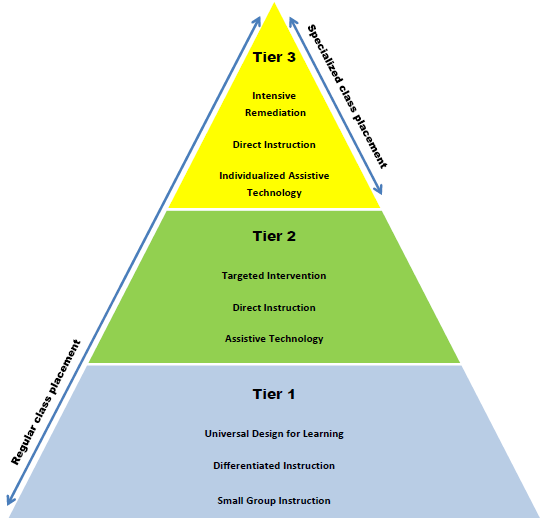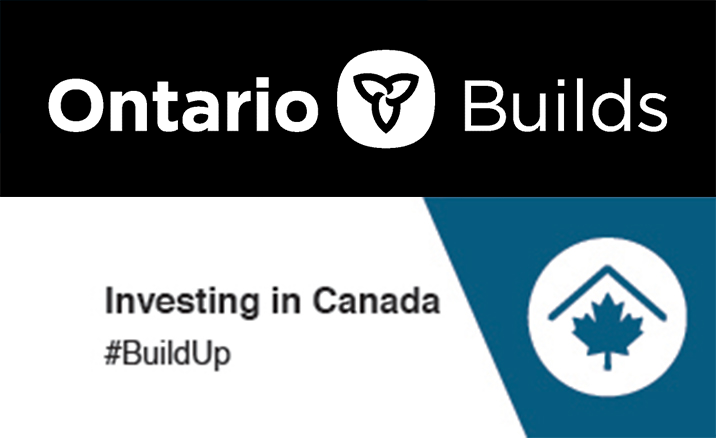The Waterloo Region District School Board (WRDSB) uses a tiered approach to program for students’ needs, including those students with a learning disability. A tiered approach allows a continuum of supports and interventions to be provided based on the intensity of a student’s learning needs. In a tiered approach, student progress is monitored regularly so that learning needs can be identified early and more intensive intervention provided if appropriate. The Ministry of Education’s document, Learning for All (pp. 12-16), provides more information on a tiered approach.
Figure 1 is an example of a tiered approach for students with learning disabilities. As Figure 1 illustrates, all tiers of instructional supports are available to students with learning disabilities in a regular class placement. The vast majority of students with learning disabilities are supported within the context of high quality classroom instruction. Students in congregated classes require intensive, individualized Tier 3 supports.

Figure 1. A Tiered Approach for Students with Learning Disabilities
Tier 1
Universal Design for Learning (UDL) and differentiated instruction are used to adapt and modify instruction to support students with learning disabilities. A UDL approach instructional strategies and resources that are essential for some students, but beneficial for all. For example, many students with learning disabilities require adaptive computer software such as text-to-speech, speech-to-text, or word prediction software, but all students can benefit from access to computers. All students benefit from instruction that is differentiated to engage their interests and skills; students with learning disabilities require differentiated instruction to enable them to access the curriculum and demonstrate their thinking. Students with learning disabilities are engaged through effective classroom instruction that allows for flexibility and inclusion.
Tier 2
Tier 2 supports are provided through the development of an Individual Education Plan (IEP). Supports may include accommodations, curriculum modifications, and/or targeted interventions to address academic or emotional/behavioural learning needs. For example, evidence-based, direct instruction interventions such as Corrective Reading and the Empower TM Reading Program are used to develop the skills of struggling readers. The following links will provide for more information on these reading interventions:
- Corrective Reading
- Empower™
Learning disabilities also affect areas of learning such as organization, social skills, executive functioning, and other cognitive processes. Direct instruction, small group or individualized coaching are commonly used to address these learning needs. Frequent use of technology (e.g., GoogleApps for Education) and assistive programs are essential accommodations for students with learning disabilities in the areas of reading and written expression. Specialized training is provided so that students are equipped to use computer programs and devices effectively.
Tier 3
Tier 3 supports are offered to students with learning disabilities who require highly individualized and intensive supports to access the curriculum in a specialized classroom environment. In most cases these students have been receiving Tier 1 and 2 supports. Intensive remedial approaches for reading, math, and writing are the foundational components delivered in these specialized class settings. Precise, explicit, personalized instruction is required to address significant challenges identified in the student’s LD profile. Executive functioning, social skills, and self-advocacy are taught directly in a supportive environment, with the expertise of additional support staff as needed. Specialized training is provided to support extensive use of assistive technology (i.e., access to specialized funding for adaptive technology). As a student progresses through the later elementary years and into secondary school, accommodations are supported within an integrated classroom setting.
Transition planning is a core component of program planning for students with a learning disability who have an IEP (see Program Policy Memorandum 156 for more information on transition planning). Transition planning can include transitions from class to class or activity to activity to transitions from elementary to secondary school or from secondary to post-secondary education.
Categories: Learning Tags: learning disabilities · programs · support · tiered support

